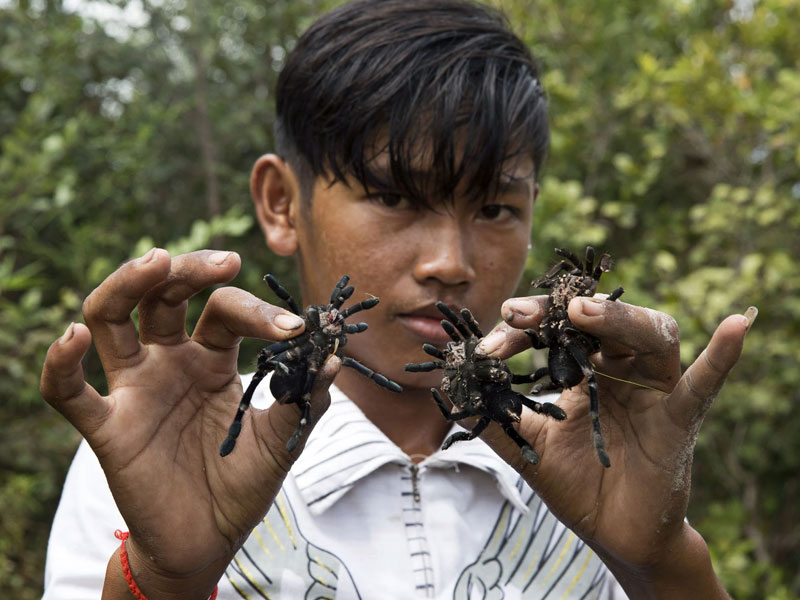How to handle a Joro spider bite is essential knowledge that Americans need to equip right now. More than 1 billion Joro spiders are preparing to attack the United States.
-
Joro spiders are tending to invade New York
Joro spiders, a giant spider originating from East Asia, are spreading across the East Coast of the United States, including New York.
This spider species first appeared in the US in 2013 through shipping containers. They have quickly spread through many states such as Georgia, Alabama, Tennessee, and Maryland. According to experts, it is only a matter of time before the Joro spider comes to New York
Joro spiders are quite large, with a body length of up to 8 inches. They can “fly” thanks to using spider silk to form small parachutes to help them move with the wind.
This ability helps them spread quickly and widely, and they can even follow cars to move. How to handle a Joro spider bite needs to be equipped now.
-
The largest Joro spider size
Joro spiders are quite large compared to many other spiders. Their size can be up to 8 inches (about 20 cm) including leg length. The body of a female spider can be 0.7 to 1 inch (about 1.8 to 2.5 cm) long, while the body of a male spider is usually smaller, only about 0.3 to 0.4 inches (about 0.8 to 1 cm) long.
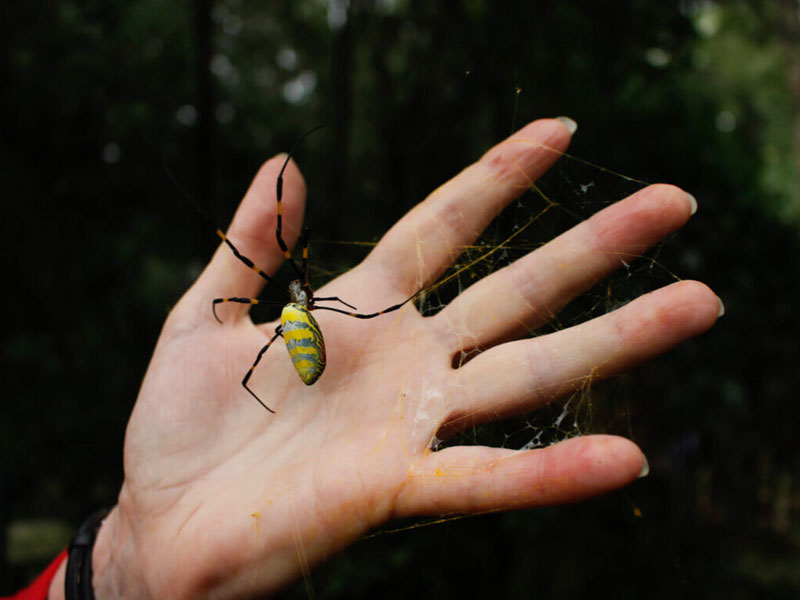
The Joro spider has a jet-black body with yellow stripes and dark red dots on its underside. They often build large, characteristic yellow webs, helping them easily hunt prey and move through the air.
-
How did the Joro spider get to Georgia?
Joro spiders reached Georgia, USA in 2013 via shipping containers from East Asia. Specifically, they follow international cargo ships and hide in shipments and luggage transported by sea.
This helps them overcome large geographical distances and establish a presence in new areas
Joro spiders are very good at colonizing new areas. They take advantage of the ability to move through the wind and follow vehicles such as cars to expand their living range.
Their rapid and widespread movement has led to their appearance in many different states in the US within just a few years of their introduction.
-
What to do when a Joro spider bites – can a Joro spider fly?
Joro spiders don’t actually “fly” like birds or winged insects. But they can move through the air using a method called “ballooning”.
When they hatch in spring, Joro spiders produce long, thin silk threads. Then the silk into the air to create small parachutes to help them be blown away by the wind. Thanks to this method, they can travel very long distances, up to 160 km.
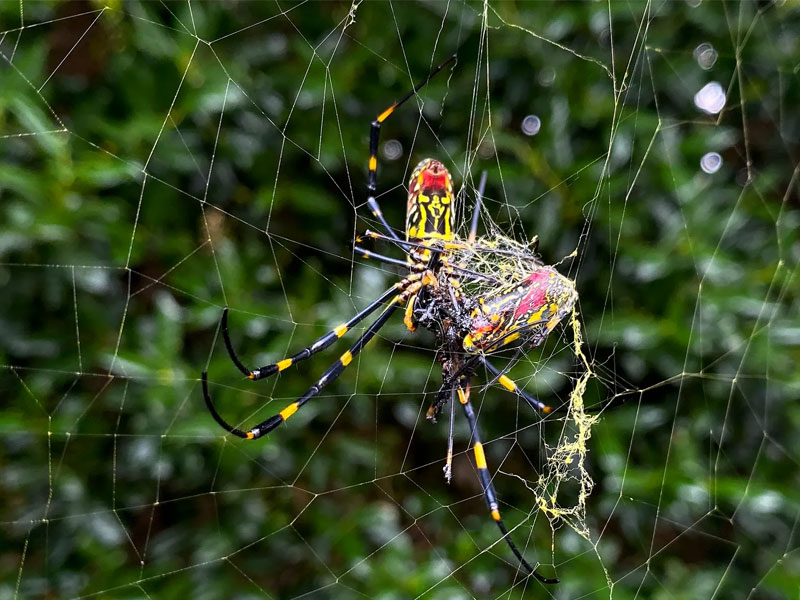
The Joro spider uses its silk to form an “umbrella web”. They rely on wind power to move to new areas. This helps them spread quickly and effectively. How to handle Joro spider bites needs to be learned early.
-
Are Joro spiders dangerous?
How to handle a Joro spider bite is very important. So is this spider dangerous?
Joro spiders are not considered dangerous to humans. Despite their large size and fearsome appearance, their venom is not strong enough to cause serious harm. Joro spiders have small fangs and their venom is mainly aimed at hunting smaller insects, not humans.
-
Symptoms of being bitten by a Joro spider
When you have symptoms of a spider attack, you need to firmly understand how to handle a Joro spider bite. If bitten by a Joro spider, symptoms are usually mild and similar to being bitten by other insects, including:
Mild pain or itching at the bite site.
Swelling or redness around the bite area.
Mild discomfort, which may last a few hours to a few days.
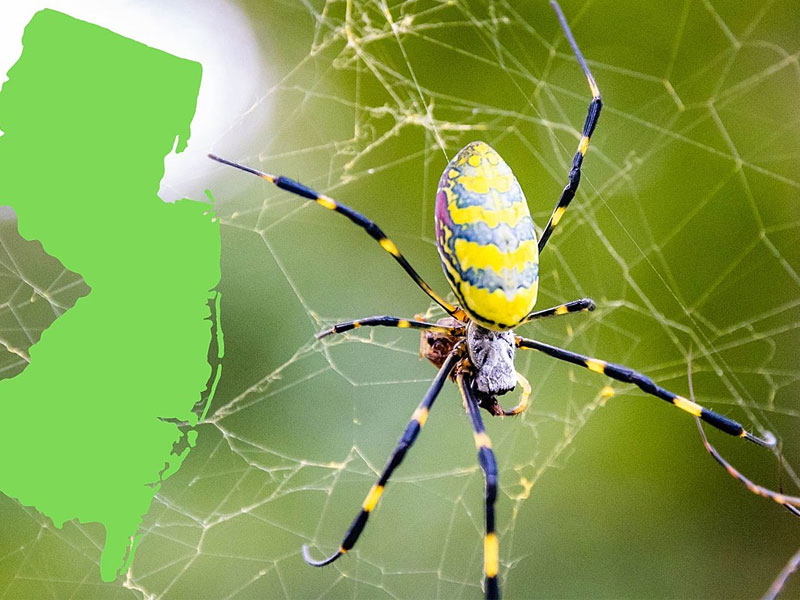
In the majority of cases, Joro spider bites do not require special medical care and can heal on their own. However, if you are allergic to insect bites or develop severe symptoms such as difficulty breathing, dizziness, or hives, you should seek medical help immediately.
-
How dangerous is the venom of the Joro spider?
Joro spiders are venomous, but their venom is not considered dangerous to humans.
This venom is mainly used to hunt prey, such as smaller insects. However, you still need to know how to handle a Joro spider bite.
-
Impact of Joro spider venom on humans
Does not cause serious harm: Joro spider venom is not strong enough to cause serious health problems in humans. Their bites usually only cause mild symptoms such as pain, itching, or mild swelling around the bitten area.
Mild reactions: Reactions to bites are often similar to those of mosquito or ant bites, and may resolve on their own in a few hours to a few days without requiring special medical treatment.
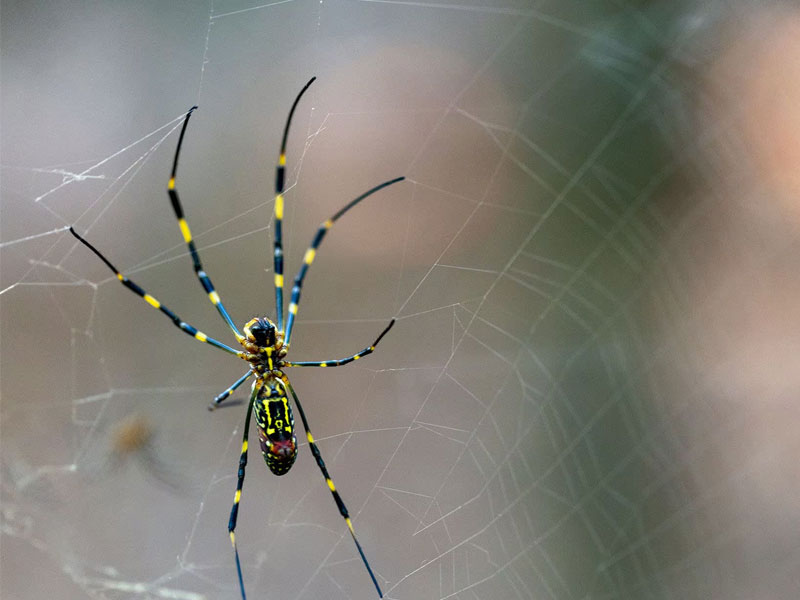
Does not cause severe allergic reactions: In the majority of cases, Joro spiders do not cause severe allergic reactions. However, if a person is allergic to insect bites, they may need to pay attention and seek medical help. How to handle a Joro spider bite when there are serious symptoms such as difficulty breathing or a rash all over the body
-
Benefits of Joro spiders
Joro spiders can cause concern due to their size and new presence. Joro spiders are also beneficial in controlling other insect pests, such as mosquitoes and flies. They contribute to crop protection and the reduction of harmful invasive species.
-
How to treat a Joro spider bite – a Joro spider antivenom?
Currently, there is no specific antivenom available for Joro spiders, mainly because their venom does not pose a danger to humans. Therefore, treating bites from Joro spiders usually only requires basic home care measures.
Home care measures when bitten by a Joro spider
Reduce pain and swelling:
- Apply ice: Use an ice pack or cold towel on the bitten area for 15-20 minutes to reduce swelling and pain.
- Use over-the-counter pain relievers: Acetaminophen or ibuprofen can help reduce pain and swelling.
- Watch for symptoms: Although rare, if you experience signs of a serious allergic reaction such as difficulty breathing, a generalized rash, or dizziness, you should seek medical help immediately.
- Therefore, learning how to handle a Joro spider bite is very important.
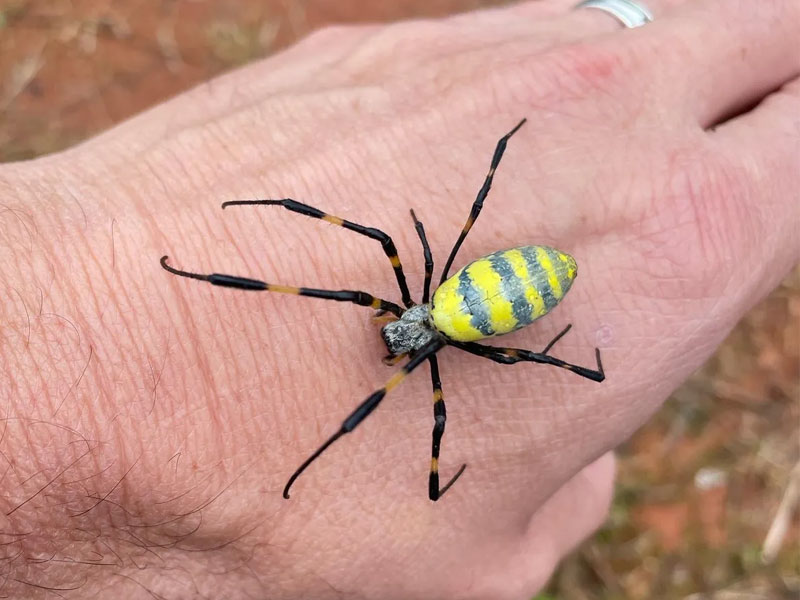
When to see a doctor
- If the bite becomes red, swollen, or infected.
- If you have a serious allergic reaction.
- If symptoms do not improve after a few days or get worse.
- Expert advice
- Experts advise that using insecticides is not the optimal method to deal with Joro spiders, because it can also kill other beneficial insects.
- If Joro spiders appear in your house, you can use a stick or broom to move them out
-
How to identify black and yellow joro spiders
Joro spiders have very distinctive and impressive colors, making them easy to identify:
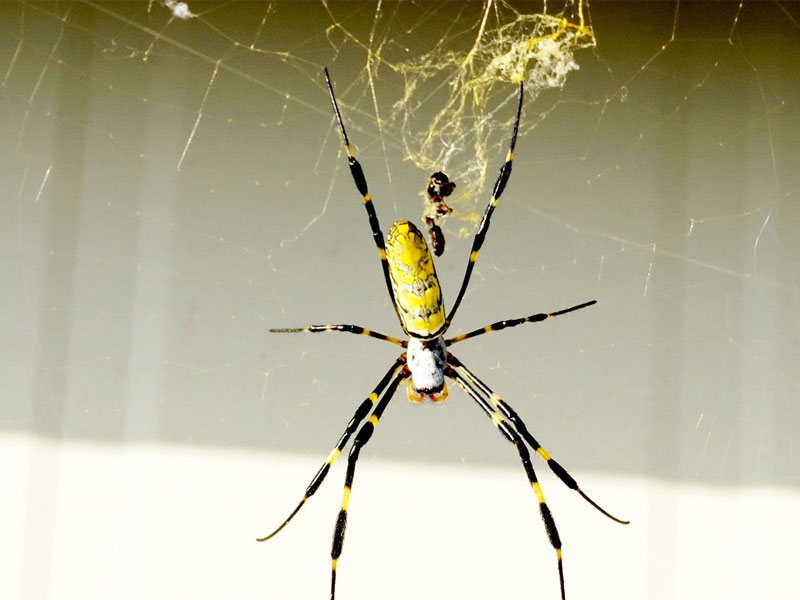
Black body with yellow stripes: Most of the Joro spider’s body is jet black, with bright yellow stripes running along its length.
Red markings on the underside: The underside of the spider has dark red dots, creating a strong color contrast.
Long and striped legs: Joro spider’s legs also have alternating yellow and black stripes, contributing to their eye-catching and scary appearance
-
Should I kill the Joro spiders?
Joro spiders do not pose a significant danger to humans and may even be beneficial. They control harmful insects.
Moving them out instead of killing them may be a better option for both you and the surrounding ecosystem.
If Joro spiders appear in your house, you can use a stick or broom to move them out
-
How to identify black and yellow joro spiders
Joro spiders have very distinctive and impressive colors, making them easy to identify:
Black body with yellow stripes: Most of the Joro spider’s body is jet black, with bright yellow stripes running along its length.
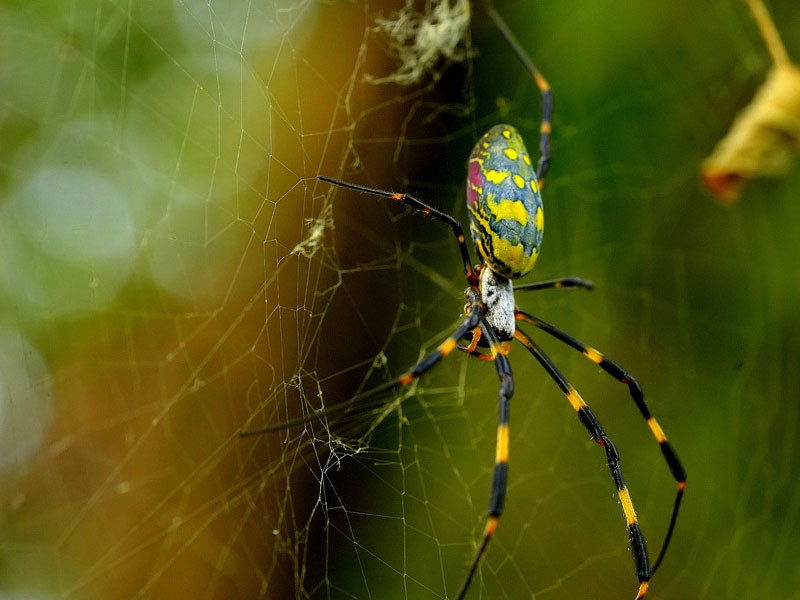
Red markings on the underside: The underside of the spider has dark red dots, creating a strong color contrast.
Long and striped legs: Joro spider’s legs also have alternating yellow and black stripes, contributing to their eye-catching and scary appearance
-
Should I kill the Joro spiders?
Joro spiders do not pose a significant danger to humans and may even be beneficial. They control harmful insects.
Moving them out instead of killing them may be a better option for both you and the surrounding ecosystem.
-
Can I hold the Joro spider?
If you know how to handle a Joro spider bite, you can handle it too. Animal experts recommend that it is best to let the Joro spider move on its own and avoid direct interaction.
If you encounter spiders in your home, use tools such as brooms or sticks to gently remove them instead of handling them with your bare hands.
In short, in most situations, Joro spiders should not be handled with bare hands. Use safe methods to move them to protect both you and the spider.
-
Difference between joro spider and banana spider
Joro spiders (Trichonephila clavata) and banana spiders (Phoneutria) are two types of spiders that differ in appearance, biology, and distribution.
Appearance:
- Joro Spider: Joro Spider is a spider belonging to the Araneidae family, with a characteristic appearance of yellow or orange color. They often create large spider webs.
- Banana spider: Banana spider is a poisonous spider belonging to the Ctenidae family, usually brown and looks quite similar to a sand spider.
Biology and behavior:
- Joro Spider: Joro Spiders often live in rural areas of Japan. They often create large webs in places with lots of light to catch prey such as flying insects.
- Banana spider: Banana spider is a poisonous spider to humans, often found in the tropical forests of Central and South America. They can attack humans if they feel threatened.
Their bites can cause serious symptoms such as pain and seizures. Therefore, learning how to handle a Joro spider bite is very important.

Distribution:
- Joro spider: Mainly distributed in Japan and some other areas of Asia.
- Banana spider: Mainly distributed in tropical forests of Central and South America.
In short, Joro spiders and banana spiders are two different spider species in appearance, biology, and distribution. Joro spiders are usually not toxic to humans, while banana spiders can be dangerous if bitten. Therefore, learning how to handle Joro spider bites is very important.
Read more: 30+ cicada dishes: Easy to make, delicious like a restaurant
